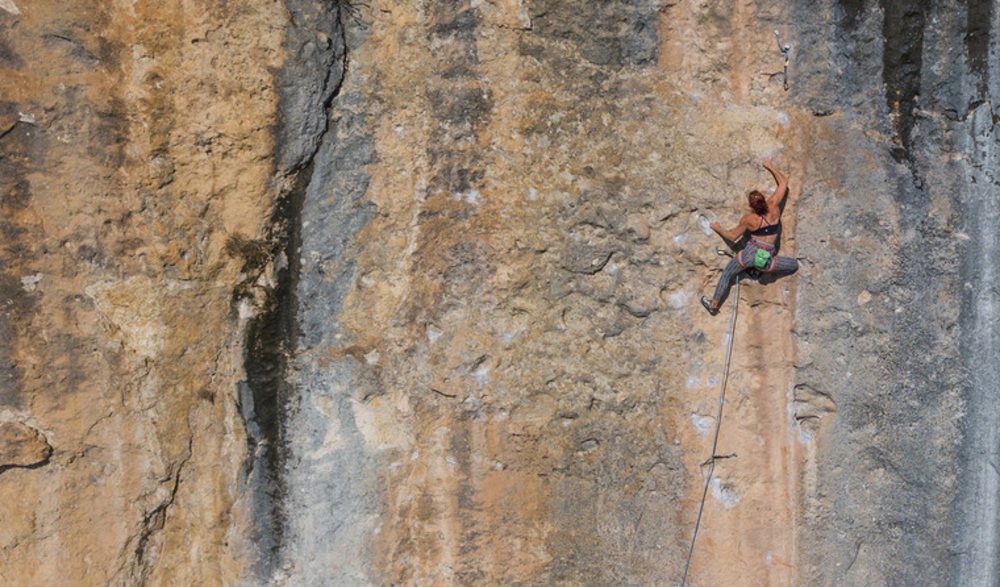Get Endless Endurance for Your Next Sport Climbing Trip
Lead route laps help prepare the mind and body for sending pumpy routes at your limit

Do you have a sport climbing trip coming up soon? Need to get some endurance ASAP? A great training tool to get you into lead shape quickly—both mentally and physically—is lead route laps.
In lead route laps (also sometimes called route intervals), you lead climb a route multiple times in a row with minimal rest in between. While there are other training methods for building endurance quickly (e.g. hangboard repeaters, TreadWall training, bouldering 4x4s), lead route laps directly translate to outdoor lead climbing by giving you the opportunity to work on your technique, rope management, lead head, and falls—all while enduring an intense pump. Here’s how they work:
Lead Route Laps
1. Choose a route a grade or two under your max onsight ability. For example, if you can usually onsight 5.12b, climb a 5.11d.
2. Lead climb the route. Focus on good technique, a relaxed grip, comfortable clipping positions, and moving at your typical outdoor climbing pace. If you find good rests, do not use them. You can take a very quick shake but then move on. The purpose of this training is to get pumped.
3. At the chains, either clip or take a fall. Regular fall practice is beneficial for most climbers.
4. Get your partner to lower you down quickly (but safely). Pinch your thighs or squeeze your hands to prevent the opportunity to recover during the lower.
5. Immediately after reaching the ground, jump back on the wall. Choose either good recovery holds or poor holds to prevent recovery—more on this below.
6. Get your partner to detach their belay device and pull the rope through the chains. They should start pulling the rope from your end of the rope, just above your tie-in point, so that you won’t have to untie and retie. They should call “Rope!” when the end of the rope slips though the chains as it won’t be sliding back down through the quickdraws. It will instead rocket straight to the ground.
7. Get your partner to put you back on belay. Be sure to double-check each other’s systems before you set off on your next lap.
8. Repeat this process for the desired length (more on this below). If you accidentally fall during one of your laps, lower back down and get back on the wall immediately.

Important Considerations
While this all might sound simple in design, the details matter. Route type selection, the number of laps you’ll perform, and the rest holds you choose will make or break your success outdoors.
Route type selection should be dictated by the types of routes you’ll be climbing outside. For example, if you’re going to the Red River Gorge, get on steep, athletic routes. If you’ll instead be in Skaha, try slightly overhanging, crimpier routes.
It can be a good idea to choose a section of your gym’s climbing wall that has multiple routes set on it. Your goal might be to climb the 5.11d, but as you get more and more tired through your laps it can be helpful to grab holds on an easier climb here or there, especially through crux sections.
The total length you climb should also be dictated by the types of climbs you’ll be doing. Many routes at Red River Gorge, for example, are under 80 feet while in Greece or Spain you’ll need to be prepared for 130-foot lines. If your gym has 40-foot walls, two or three laps will likely be sufficient for the Red but you might want to try at least four laps if you’ll be heading to Kalymnos.
The goal is to just barely make the chains or fall just below the chains on your final lap. You should have a very, very deep pump. Try to choose routes that don’t have tweaky boulder problems as you don’t want to get injured climbing through these in a fatigued state.
The rest holds you choose between laps should also be dictated by the types of routes you’ll be on outside. Some areas have routes full of good juggy rests. If this is this case, use juggier holds to try and recover. However, if the area you’ll be climbing in has generally poor resting positions, get on worse holds (e.g. edges, slopers) in between your laps to prevent your pump from dissipating too much.
After completing one set of laps, rest for 15 minutes and then complete another set. Advanced climbers could aim at performing three to four sets, with each set being separated by at least a 15-minute rest period. Add lead route laps into your training routine twice per week.


